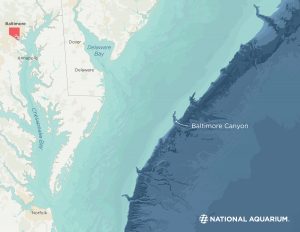
OCEAN CITY — The National Aquarium on Monday announced it is seeking the public’s support in its effort to nominate the Baltimore Canyon off the coast of Ocean City as the nation’s first Urban National Marine Sanctuary.
The Baltimore Canyon, a 28-mile long and five-mile wide submarine canyon off the coast of Ocean City lies at the center of the resort’s multi-million dollar fishing industry and contains fragile deep sea corals rarely seen anywhere in the world along with habitat for countless species of marine life. The National Aquarium has launched a petition drive to have it designated as the nation’s first Urban National Marine Sanctuary, presenting a unique opportunity to connect an urban population to the ecological treasure using cutting edge deep sea exploration technology.
“The Baltimore Canyon is not only a fascinating ecosystem, but also a natural classroom and living laboratory that we can use to expose our children to a new world, our next frontier,” said National Aquarium Chief Conservation Officer Kris Hoellen. “We hope that with a groundswell of support from our community, we can designate this untapped aquatic treasure as our nation’s first Urban National Marine Sanctuary. It is time to invest in our deep seas and in Baltimore.”
Created millions of years ago, the canyon offers unprecedented ecological and educational value, according to the National Aquarium. In addition to protection from man-made threats, the National Aquarium hopes to gain special recognition for the Baltimore Canyon as the first Urban National Marine Sanctuary offering a groundbreaking opportunity for the public to connect and engage with the deep sea. The National Aquarium hopes to create a virtual high-tech system to connect discoveries from researchers in the canyon back to scientists, students and institutions on the mainland.
The National Aquarium is in the first states of the designation process with the National Oceanic and Atmospheric Administration (NOAA) Office of Marine Sanctuaries. The first step is the petition drive to gain public support for the designation although the process could take as long as three years. If NOAA deems the Baltimore Canyon worthy of the designation, other steps would include an environmental impact assessment after which a series of public hearings would be conducted.
Already, there is an effort to designate the Norfolk Canyon to the south of Ocean City, which is also frequented by the resort area’s vast recreational fishing industry, as a national marine sanctuary. That effort is being led by the Virginia Aquarium and Marine Science Center.
There are currently 13 designated national marine sanctuaries, but the Baltimore Canyon would be the first Urban National Marine Sanctuary. The first national marine sanctuary was created in 1975 off the coast of North Carolina’s Cape Hatteras to protect the wreck of the Monitor, an ironclad deployed by the Union in the Civil War.
While a national marine sanctuary designation for the Baltimore Canyon could limit or prohibit some activities, it is not expected to curtail recreational fishing, which is vastly important to the resort’s economy. According to the petition released on Monday, not only would fishing not be prohibited, but would be encouraged if the Baltimore Canyon received the designation.
“Measures put in place to protect vanishing habitats are often at odds with commercial necessity and economic progress,” the petition reads. “In this case, however, what is good for the Baltimore Canyon is good for all of us. Protection of the Baltimore Canyon and surrounding waters does not call for the exclusion of the canyon from fishing or recreational use. In fact, the existing network of national marine sanctuaries supports $4 billion in marine-related economies annually and they are exceptional sites for both commercial and recreational fishing.”
The issue is further addressed in the “frequently asked questions” section of the petition. One question asks, “Does protective status impact how people can use and enjoy the waters in and around the canyon?” and the answer given is “In short, no. Preservation of most national marine sanctuaries ensures not only that the area is protected for ecological reasons, but also for continued appropriate recreational and commercial use.”
While the potential designation of the Baltimore Canyon as an Urban National Marine Sanctuary on the surface does not appear to impact fishing and other recreational uses, it would prohibit offshore drilling for oil and natural gas. The federal government had included a vast section of ocean off the mid-Atlantic coast as a potential lease area for private sector offshore drilling, but backed off that proposal last year. However, the mid-Atlantic does remain a potential area for controversial offshore seismic testing for oil and gas reserves. In addition, it is uncertain at this point what a designation would mean for the future offshore wind farm off the resort coast.
While an Urban National Marine Sanctuary designation for the Baltimore Canyon does not appear to impact fishing and other recreational uses, it certainly bears monitoring. Earlier this fall, the Obama administration designated a vast area the size of Connecticut off the coast of Cape Cod as the Northeast Canyons and Seamounts Marine National Monument, the first of its kind in the Atlantic. Marine National Monuments are far more restrictive than national marine sanctuaries. The long-range plan is to phase out all commercial fishing in the marine national monument off the coast of Cape Cod although recreational fishing will still be allowed.
The petition can be accessed online at www.aqua.org/baltimorecanyon.

